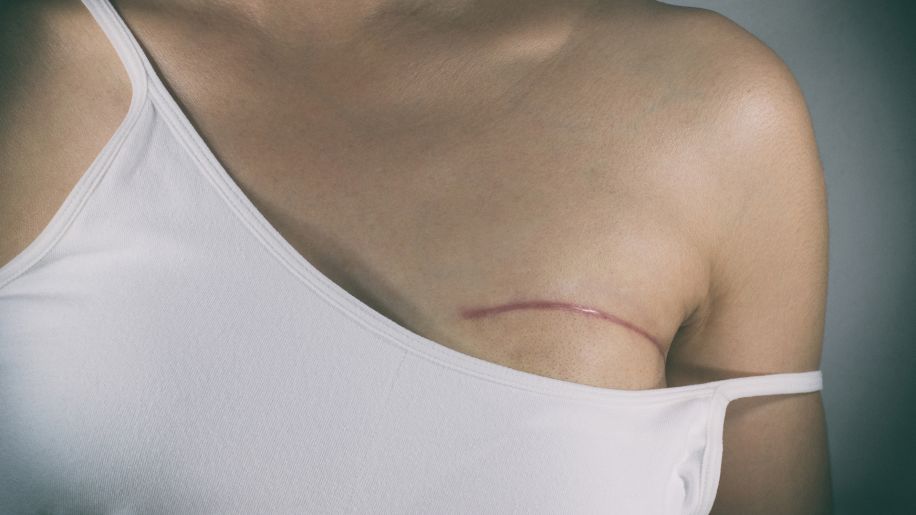8 things your breast cancer surgeon wishes you knew
Your deodorant isn't a cause, you can control some risk factors, and that's just for starters.
Updated on August 30, 2024

By the end of 2024, it's estimated that almost 311,000 women in the United States will be diagnosed with invasive breast cancer, a number that continues to increase each year. Over 42,000 women are expected to die of the disease, according to the American Cancer Society (ACS).
Although this number may seem high, it’s much lower than in the past. And even though both… Show More
By the end of 2024, it's estimated that almost 311,000 women in the United States will be diagnosed with invasive breast cancer, a number that continues to increase each year. Over 42,000 women are expected to die of the disease, according to the American Cancer Society (ACS).
Although this number may seem high, it’s much lower than in the past. And even though both awareness and survival rates are improving, misconceptions still exist about this increasingly treatable condition.
"There's a lot of hope for you," says Renee Quarterman, MD, FACS, a breast surgeon with Delaware Breast Care in Wilmington, Delaware. "There's a lot of hope for all patients with breast cancer." Find out the truth behind popular breast cancer myths, along with what Dr. Quarterman wishes everyone knew about the condition.
Show Less
Most cases are not inherited
It’s true that your risk for breast cancer is higher if you have a close family member who has had the disease. This includes having at least one close relative diagnosed before age 50, or multiple cases on the same side of the family. And it doesn't have to be your maternal side of the family.
It’s true that your risk for breast cancer is higher if you have a close family member who has had the disease. This includes having at least one close relative diagnosed before age 50, or multiple cases on the same side of the family. And it doesn't have to be your maternal side of the family.
According to the Centers for Disease Control and Prevention (CDC), about 10 percent of breast cancers occur in women under the age of 45. Breast cancer that occurs earlier may be more likely to be caused by genes that are passed down in families.
"A lot of people think, 'Well, that breast cancer is on my dad's side so it doesn't matter,'" says Quarterman. "But it does matter." When assessing your risk, she adds, it's important to get histories from both sides of the family.
In many cases, though, breast cancer can be linked to lifestyle factors.
"Most breast cancers are not caused by genetic mutations," says Quarterman.
Show Less
It's linked to lifestyle
While family history plays a role, breast cancer risk is influenced in large part by lifestyle choices, says Quarterman. These include:
Drinking alcohol: The more you imbibe, the higher your risk, and there is no “safe” amount that won’t raise your risk. According to the ACS, even one drink… Show More
While family history plays a role, breast cancer risk is influenced in large part by lifestyle choices, says Quarterman. These include:
Drinking alcohol: The more you imbibe, the higher your risk, and there is no “safe” amount that won’t raise your risk. According to the ACS, even one drink per day increases the risk by about seven to 10 percent. Those who have two to three drinks daily have about a 20 percent greater risk than those who don't drink at all.
Postmenopausal overweight or obesity: Though the relationship between fat and breast cancer is still being explored, it's thought that excess weight gained after menopause increases your estrogen levels, raising your chances of the disease. Being overweight can raise your blood insulin levels, too, which may raise your risk for breast cancer.
Physical inactivity: Physical activity can have a protective effect against breast cancer, possibly because of the ways it can affect hormone levels, inflammation, and body weight. ACS recommends getting 150 to 300 minutes of moderate intensity activity each week, or 75 to 150 minutes of vigorous activity. It’s also a case of the more, the better—aim for or above the upper limit of time, as you are able.
Never having been pregnant: If you haven’t been pregnant, or didn’t have your first child until you were over 30, you’ll have a slightly higher risk of breast cancer. If you’ve had many pregnancies and/or were pregnant at a young age, you’ll have a lower risk. But pregnancy’s effects on breast cancer risk varies. For example, for about 10 years after having a child, your risk is higher, and then it lowers again over time.
Breastfeeding: More research is needed, but so far studies have shown that if you breastfeed, and especially if you do it for a year or longer, you may have slightly lower risk of breast cancer. Most Americans breastfeed for less than the recommended time period (six months exclusively, and combined with other foods for a year or longer) but it’s not clear if a shorter duration is linked to reduced risk.
Birth control and certain hormone therapies: Certain types of birth control that use hormones, including implants, intrauterine devices (IUDs), skin patches, and vaginal rings, may contribute to a higher risk. However, most of the research so far is on IUDs. After menopause, use of combined hormone therapy that includes synthetic estrogen and progesterone may be associated with a higher risk of breast cancer. However, hormone therapy with estrogen alone doesn’t seem to pose as much of a risk.
Show Less

It doesn’t necessarily hurt
Though mammograms can pinch and treatments like radiation and chemotherapy often come with uncomfortable side effects, breast cancer itself isn’t typically painful. “Women will tell me that they have a lump, and we find out that it’s cancer,” says Quarterman. “They say, ‘It didn’t hurt. I didn’t… Show More
Though mammograms can pinch and treatments like radiation and chemotherapy often come with uncomfortable side effects, breast cancer itself isn’t typically painful. “Women will tell me that they have a lump, and we find out that it’s cancer,” says Quarterman. “They say, ‘It didn’t hurt. I didn’t think it was cancer.’”
While pain is possible, you may notice other symptoms first. Lumps and masses are the most common signs of the disease, though you should also keep an eye out for changes in the appearance of your breast. These include:
- A lump or mass
- Swelling
- Skin irritation, thickening, scaling, redness, or dimpling of the breast or nipple
- Nipples turning inward
- Nipple discharge that isn’t breast milk
- Changes in shape and size
While a lump or mass may be a sign, most of them are not cancer. But if you're experiencing one or more signs of the disease, contact your healthcare provider (HCP) as soon as you can.
Show Less
Your bra and antiperspirant don't cause it
You may have heard that your antiperspirant can give you breast cancer. The theory goes that chemicals seep into your skin, or your roll-on prevents you from sweating, leading to a buildup of toxins. Some even think that antiperspirant is absorbed through underarm shaving cuts, causing the disease.… Show More
You may have heard that your antiperspirant can give you breast cancer. The theory goes that chemicals seep into your skin, or your roll-on prevents you from sweating, leading to a buildup of toxins. Some even think that antiperspirant is absorbed through underarm shaving cuts, causing the disease. But it's just not true.
"There has been concern about certain types of deodorants, or maybe having aluminum in your deodorant," says Quarterman. "But that hasn't been borne out yet in any study." She suggests wearing whatever deodorant/antiperspirant works for you. And if you're still worried, try brands that are labeled as natural or less processed.
The same goes for bras, which some say cause cancer by preventing lymph nodes from draining correctly. “We don’t have any evidence that the type of bra that you wear causes breast cancer,” says Quarterman. “Again, wear what works for you.”
Show Less
Early detection is crucial
According to the ACS, with treatment, the five-year survival rate of someone with localized breast cancer (which is confined to the breast) is 99 percent. Those with regional breast cancer—meaning the cancer has spread to nearby areas—have an 86 percent chance of surviving for five years. When… Show More
According to the ACS, with treatment, the five-year survival rate of someone with localized breast cancer (which is confined to the breast) is 99 percent. Those with regional breast cancer—meaning the cancer has spread to nearby areas—have an 86 percent chance of surviving for five years. When breast cancer spreads to distant parts of the body, the survival odds drop to 30 percent.
"The earlier we find breast cancer, the more successful we are in treating it," says Quarterman. "So, I encourage women to stay on top of their mammograms." Though they’re not perfect, mammograms remain the most effective way of detecting the disease.
How often to get screened and at what age to start screenings vary according to different health experts. The recommendation from ACS is that women between ages 45 and 54 are advised to get annual mammograms, while those 55 and older should switch to every other year.
The recommendation from the United States Preventive Services Task Force is slightly different. Women aged 40 to 74 with average risk factors are advised to have a mammogram every two years. Women between age 40 and 49 should have an informed talk with their HCP about the best time to begin screenings, based on family history and risk factors.
One important risk factor involves breast density. There are four categories of breast density:
- About 10 percent of women have breasts mostly made of fatty tissue
- 40 percent of women have mostly fatty tissue with a few dense spots
- Another 40 percent have heterogeneously (evenly) dense breasts
- About 10 percent of women have extremely dense breasts
When you get a mammogram, federal law requires mammography providers to inform you about your breast density. If you’re among the approximately 10 percent with extremely dense breasts, then you have a higher chance of developing breast cancer.
Dense breasts make it harder to see cancerous tissue in a mammogram. Unfortunately, a cancerous tumor can look very much the same as dense breast tissue, so it could be overlooked.
Your HCP may recommend other kinds of screening tests, like breast ultrasound or breast magnetic resonance imaging (MRI). It’s important to talk with your HCP about all your risk factors to decide on the most appropriate screening methods and frequencies for you.
.
Show Less
It's deadlier for Black women
Black women are diagnosed with breast cancer at nearly the same rate as white women overall. However, when it comes to women under age 40, breast cancer is more common in Black women.
Black women are around 40 percent more likely to die of the disease. Access to healthcare and racial disparities in… Show More
Black women are diagnosed with breast cancer at nearly the same rate as white women overall. However, when it comes to women under age 40, breast cancer is more common in Black women.
Black women are around 40 percent more likely to die of the disease. Access to healthcare and racial disparities in treatment each play a role. Breast cancer in Black women is often detected at later stages, and follow-up care may be delayed. Black women are also more likely to develop the disease at a younger age (60 years old for Black women versus 62 for white women). These disparities and differences are not the only factors, however, says Quarterman.
"When you control for the stages of breast cancer, African American women still have worse outcomes than their white, Latina, or Asian counterparts," she says. "There's something about the biology of breast cancer in a lot of African American women that confers a worse prognosis."
For example, Black women are more likely to develop triple-negative breast cancer, which is more aggressive, harder to treat, and more likely to recur and spread. Still, finding a cancer as early as possible is key to having the best odds of successfully treating it. Five-year relative survival rates for women diagnosed with triple-negative breast cancer are very high (91 percent) if the cancer is still localized when it’s found, meaning it hasn't yet spread.
Show Less
Men can—and do—get it
In 2024, an estimated 2,800 men in the United States will be diagnosed with invasive breast cancer. It will kill around 530 of them. Men don't often realize they have it—or that they can develop it at all—and may be uncomfortable discussing the issue with their HCP.
"If you have a nipple, you could… Show More
In 2024, an estimated 2,800 men in the United States will be diagnosed with invasive breast cancer. It will kill around 530 of them. Men don't often realize they have it—or that they can develop it at all—and may be uncomfortable discussing the issue with their HCP.
"If you have a nipple, you could get breast cancer," says Quarterman. "It's important to check yourself and not be afraid to talk to somebody, not be embarrassed to talk to your doctor and get examined."
This is especially true if you find a lump in your breast area, which is the most common sign, or have other symptoms typical to breast cancer. Much like Black women, Black men are less likely to be diagnosed with breast cancer but face worse prognoses or outlooks.
Show Less
Many people survive breast cancer
Thanks to a combination of increased awareness, early detection, and better treatment, breast cancer death rates have dropped substantially in recent decades. Between 1989 and 2020, they fell about 43 percent.
"I tell my patients that you don't need to change any of your long-term plans, because… Show More
Thanks to a combination of increased awareness, early detection, and better treatment, breast cancer death rates have dropped substantially in recent decades. Between 1989 and 2020, they fell about 43 percent.
"I tell my patients that you don't need to change any of your long-term plans, because there's a lot that we can do," says Quarterman. That's largely because treatment can be customized to the patient, now more than ever. "We can tailor therapy; we can predict who should have chemotherapy and who really doesn't need it."
Safety and technological advancements have helped, as well. "Our radiation delivery has become better and safer. Our surgery has become better and safer," she says. "All of that comes together to improve outcomes."
Show Less
American Cancer Society. Key Statistics for Breast Cancer. Page last reviewed January 17, 2024.
National Breast Cancer Foundation, Inc. Breast Cancer Facts & Stats. Page last updated August 1, 2024.
Centers for Disease Control and Prevention. Bring Your Brave. Page accessed August 30, 2024.
Centers for Disease Control and Prevention. Groups at Higher Risk for BRCA Gene Mutations. Page accessed August 30, 2024.
Centers for Disease Control and Prevention. Learn Your Family History of Breast and Ovarian Cancer. Page accessed August 30, 2024.
American Cancer Society. Lifestyle-related Breast Cancer Risk Factors. Page last updated September 19, 2022.
Anstey EH, Shoemaker ML, Barrera CM, O'Neil ME, Verma AB, Holman DM. Breastfeeding and Breast Cancer Risk Reduction: Implications for Black Mothers. Am J Prev Med. 2017 Sep;53(3S1):S40-S46.
American Cancer Society. Breast Cancer Symptoms: What You Need to Know. September 22, 2022.
BreastCancer.Org. Fears With No Evidence: Antiperspirants and Bras Do Not Cause Breast Cancer. Page last updated January 2, 2024.
American Cancer Society. Survival Rates for Breast Cancer. Page last revised January 17, 2024.
American Cancer Society. Limitations of Mammograms. Page last revised January 14, 2022.
American Cancer Society. American Cancer Society Guidelines for the Early Detection of Cancer. Page last updated November 1, 2023.
Centers for Disease Control and Prevention. Screening for Breast Cancer. Page accessed August 30, 2024.
U.S. Preventive Services Task Force. Breast Cancer: Screening. April 30, 2024.
Centers for Disease Control and Prevention. About Dense Breasts. Page accessed August 30, 2024.
American Cancer Society. Breast Cancer Risk Factors You Cannot Change. Page last updated December 16, 2021.
Blackburn, Kelletta. “Black women more likely to die from breast cancer: What factors are influencing this disparity and how can they be addressed?” Chicago Medicine. December 28, 2022.
American Cancer Society. Triple-negative Breast Cancer. Page last updated March 1, 2023.
American Cancer Society. Key Statistics for Breast Cancer in Men. Page last updated January 19, 2024.
